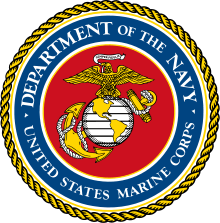Marine Corps Air Station Santa Barbara
| MCAS Santa Barbara Goleta Field | |||||||||||
|---|---|---|---|---|---|---|---|---|---|---|---|
|
Overhead MCAS Santa Barbara in April 1944 | |||||||||||
| IATA: none – ICAO: none | |||||||||||
| Summary | |||||||||||
| Airport type | Military | ||||||||||
| Location | Santa Barbara, California | ||||||||||
| Coordinates | 34°25′34″N 119°50′25″W / 34.42611°N 119.84028°W | ||||||||||
| Runways | |||||||||||
| |||||||||||
Marine Corps Air Station Santa Barbara (MCAS Santa Barbara) was a United States Marine Corps air station that was located in Goleta, California 70 miles (113 km) north of Los Angeles during World War II. Commissioned on December 4, 1942, the air station consisted of an airfield that had been built into the Goleta Slough and served as a training base for numerous squadrons before they deployed to support combat operations in the Pacific Theater. Later in the war, the station would serve as home to Marine squadrons that were trained to operate from aircraft carriers providing close air support for their fellow Marines on the ground. Following the surrender of Japan and the subsequent drawdown of forces that ensued, the air station closed its doors in 1946 and today its property is home to the Santa Barbara Municipal Airport and the campus of the University of California, Santa Barbara.
History
Early years
In the early 1930s, an airfield and flight school were established in Goleta, California that would later be named the Santa Barbara Municipal Airport. In 1940, the Civil Aeronautics Authority recommended expanding the airfield in the interest of national defense which led to the city purchasing another 568 acres (2.30 km2) and building another terminal and filling in the Goleta Slough to make way for three runways.
World War II
| Marine Corps Air Station Santa Barbara | |
|---|---|
| Santa Barbara, California | |
| Type | Military air station |
| Site information | |
| Controlled by | USMC |
| Site history | |
| Built | December 4, 1942 - March 1, 1946 |
| In use | 1942 - 1946 |
After the outbreak of war, the United States Army Air Corps began to build revetments and station P-40 interceptors at the airfield. The first Marines at Goleta came on June 14, 1942 with the arrival of Marine Aircraft Group 24 (MAG-24) and VMSB-243 and VMSB-244.[1] and expanded construction on the base began a month later on May 29, 1942. The field was officially commissioned on December 4, 1942; however, throughout 1942, the threat of a Japanese strike against the West Coast of the United States kept the base on very high alert, especially after the raid against Dutch Harbor in the Aleutian Islands. The advanced echelon of Marine Base Defense Aircraft Group 42 arrived in January 1943 and would remain for the duration of the war. Conditions surrounding the base also improved in early 1943 when the local slaughterhouse burned down and the hog farm was abandoned. Two unique conditions that affected the base were that U.S. Route 101 ran through the middle of it and during the course of the war, United Air Lines continued to use the field.[2]
In early 1944, after the Battle of Tarawa where many felt that close air support left much to be desired, General Holland Smith recommended that Marine aviators be trained to operate from aircraft carriers. In July 1944, Commandant of the Marine Corps General Alexander Vandegrift held a meeting with Admiral Chester Nimitz where it was agreed that Marine aircraft would be put on a certain number of escort carriers for the purpose of providing close air support for Marines during amphibious landings.[3] This led to the establishment of the Marine Carrier Air Group (MCVG) and the establishment of a command known as Marine Carrier Groups Pacific which would be based at MCAS Santa Barbara.[4] The goal for the unit was to have eight air groups ready for the expected invasion of Japan late in 1945.[5]
At its peak, the station housed just under 500 officers and had 3,100 enlisted men and 440 women Marines. A total of 24 squadrons trained at the base during the war[6] and 101 aviation accidents occurred at the station during this training. Following the war, the Marine Corps debated making MCAS Santa Barbara a permanent installation; however the City resisted this proposal since the facility was needed for a municipal airport and no other land in the area was suitable. The station went on caretaker status March 1, 1946 and was released to the War Assets Administration for disposal two months later. Today, substantial portions of the former air station are home to the Santa Barbara Municipal Airport and the campus of the University of California, Santa Barbara. A former hangar houses the Goleta/Santa Barbara Air Heritage Museum.[5]
See also
- Isla Vista, California
- United States Marine Corps Aviation
- University of California, Santa Barbara
- List of United States Marine Corps installations
- List of inactive United States Marine Corps aircraft squadrons
Notes
References
- Condon, John Pomeroy (1998). Corsairs and Flattops - Marine Carrier Air Warfare, 1944-45. Annapolis Maryland: Naval Institute Press. ISBN 1-55750-127-0.
- Sherrod, Robert (1952). History of Marine Corps Aviation in World War II. Washington, D.C.: Combat Forces Press.
- Shettle, M. L., Jr. (2001). United States Marine Corps Air Stations of World War II. Bowersville, Georgia: Schaertel Publishing Co. ISBN 0-9643388-2-3.
- Simmons, Edwin (1974). The United States Marines: A History. Annapolis, Maryland: Naval Institute Press. ISBN 1-55750-840-2.
External links
- Developed to Serve Wartime Need — a document from the Santa Barbara Airport with a timeline and several photos of MCAS Santa Barbara.
- Commissioned to Train Aviators — another document with more photos and details about Marine training at the station.
| |||||||||||||||||||||||||||||||||

